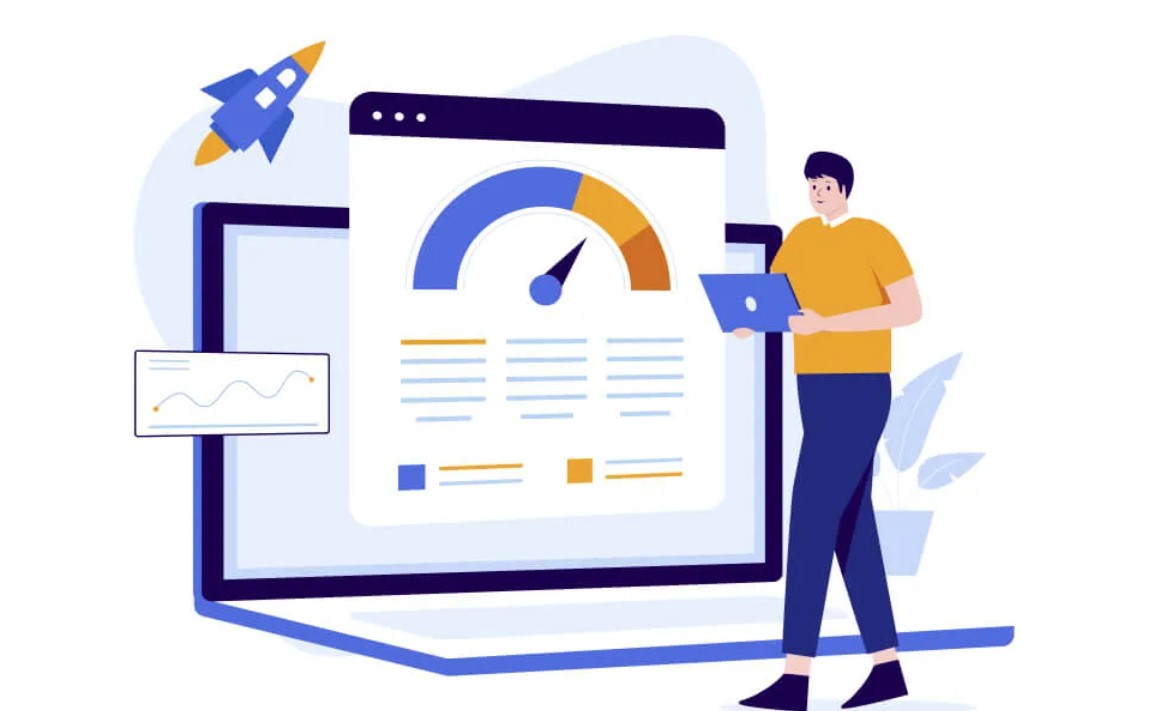How to Optimize Your Business Website for Maximum Conversions
In today’s competitive digital landscape, optimizing a business website is crucial for converting visitors into customers. Website optimization goes beyond visuals; it involves creating a fast, mobile-friendly, and high-performing site that encourages visitors to engage, take action, and ultimately convert. This guide covers proven strategies and tools to help you maximize conversions on your business website by improving site performance, optimizing for mobile, and enhancing speed.
Why Website Optimization Matters

Website optimization is essential in today’s digital world, where users expect seamless online experiences. A well-optimized website not only improves the user experience but also enhances search engine rankings, increases engagement, and drives conversions. Businesses that prioritize optimization can see significant benefits in customer satisfaction, brand reputation, and revenue generation. Here’s an in-depth look at why website optimization matters and how it can impact various aspects of your business.
1. Improved User Experience
The primary reason website optimization is crucial is to improve user experience. When users land on your website, they expect pages to load quickly, navigation to be intuitive, and content to be relevant. If they encounter slow loading times, poor mobile compatibility, or a cluttered design, they’re likely to leave, resulting in a high bounce rate and missed conversion opportunities.
- Speed and Accessibility: Optimized websites load faster, providing a smooth browsing experience that keeps users engaged. Studies show that users often abandon a page if it takes more than three seconds to load. By optimizing load times, businesses can retain visitors and improve their chances of conversion.
- Ease of Navigation: A well-structured website enables users to find what they’re looking for quickly, which enhances satisfaction. Clear navigation and intuitive design keep users engaged, reducing frustration and creating a positive experience that encourages them to explore more of the site.
2. Enhanced Mobile Accessibility
With the increasing use of smartphones and tablets, optimizing websites for mobile has become non-negotiable. Mobile optimization ensures that users on smaller screens can access your website without any issues, providing a user-friendly experience that matches desktop browsing.
- Responsive Design: Mobile-optimized sites adjust automatically to fit various screen sizes, ensuring images, text, and buttons display correctly. This responsiveness prevents issues like users having to zoom in to read content or navigate through improperly aligned elements.
- Improved User Retention: Since a significant portion of web traffic comes from mobile devices, businesses that optimize for mobile retain users who may otherwise leave due to a poor mobile experience. This retention translates to more leads, conversions, and ultimately, revenue.
3. Higher Search Engine Rankings
Search engines, particularly Google, prioritize websites that provide fast, mobile-friendly, and user-centric experiences. By optimizing your website, you align with search engine ranking criteria, which can significantly improve your position on search engine results pages (SERPs).
- Core Web Vitals: Google’s Core Web Vitals, which measure page load performance, interactivity, and visual stability, are key factors in search rankings. Websites that perform well on these metrics are likely to rank higher.
- SEO and Visibility: An optimized website makes it easier for search engines to crawl and index your pages, improving your visibility on search engines. This visibility attracts organic traffic, which is often more engaged and likely to convert compared to paid traffic.
4. Increased Conversion Rates
Website optimization directly impacts conversion rates by reducing friction in the customer journey. When users can navigate your site easily, access content quickly, and find relevant information, they’re more likely to take desired actions like signing up for newsletters, making purchases, or filling out contact forms.
- Reduced Drop-Off Rates: Optimized websites minimize common pain points, such as slow load times and difficult navigation, reducing the likelihood of users abandoning their journey. When users experience a smooth process from landing on the page to completing a purchase, conversion rates naturally increase.
- Optimized Calls to Action (CTAs): Website optimization includes designing clear, attractive CTAs that guide users toward conversion. Well-placed CTAs enhance the likelihood that users will engage and take the next step, whether it’s a purchase or a sign-up.
5. Lower Bounce Rates and Higher Engagement
A high bounce rate, which indicates that users are leaving your site after viewing only one page, is a signal of poor user engagement. Optimizing your website to load faster and offer a better user experience reduces bounce rates, encouraging visitors to stay longer and explore more.
- Content Relevance: Optimized websites provide relevant and engaging content that matches user intent. When users find valuable information, they’re more likely to continue browsing, interacting with multiple pages, and engaging with your brand.
- Interactive Elements: Optimized sites often include interactive elements, such as quizzes, videos, and polls, which encourage user participation and keep them on the site longer. This engagement helps build a connection with users and increases the chances of conversion.
6. Competitive Advantage
In competitive industries, a well-optimized website can set your business apart. Websites that load quickly, provide a seamless experience, and offer mobile accessibility are more attractive to users, especially when compared to competitors who may not prioritize optimization.
- User Preference: When users have a positive experience on your website, they’re more likely to choose your business over competitors. This advantage can result in higher customer loyalty and increased market share.
- Brand Perception: An optimized website reflects a professional, customer-centric brand image. By focusing on optimization, businesses demonstrate their commitment to quality, which builds credibility and trust with potential customers.
7. Better Resource Management
An optimized website can help businesses make better use of resources by reducing server loads, improving content delivery, and managing data efficiently. This efficient management reduces the need for extensive IT support, lowers operational costs, and makes it easier to handle increased traffic.
- Reduced Bandwidth Costs: Optimization techniques, such as compressing images and caching, reduce the amount of bandwidth required to load your website. This efficiency translates to lower hosting costs and improved resource allocation.
- Scalability: Optimized websites are better equipped to handle traffic spikes, such as during sales or peak times, without compromising user experience. This scalability ensures that your website can grow alongside your business without requiring major infrastructure changes.
8. Improved Analytics and Data Collection
Website optimization also involves ensuring that tracking and analytics tools are properly configured. This setup allows you to collect valuable data on user behavior, including how they navigate your site, which pages they visit, and what actions they take.
- Data-Driven Decision Making: With accurate data, businesses can make informed decisions about further optimizations, marketing strategies, and product development. Understanding user behavior helps businesses identify areas for improvement and invest in changes that will make the most impact.
- Enhanced Personalization: Data collected from an optimized website can be used to personalize user experiences. For example, businesses can tailor content or product recommendations based on user behavior, which improves relevance and encourages repeat visits.
9. Enhanced Brand Reputation and Trust
Users associate a smooth, professional website with a trustworthy brand. An optimized website that provides a user-friendly, mobile-accessible, and fast-loading experience is more likely to leave a positive impression, increasing trust and brand loyalty.
- Positive User Perception: A well-optimized website that offers a consistent, enjoyable experience creates positive perceptions of your brand. Users are more likely to trust a business that provides a high-quality digital experience.
- Increased Brand Loyalty: By focusing on delivering a superior user experience through optimization, businesses can foster loyalty among customers. Satisfied users are more likely to return and recommend your website to others.
10. Future-Proofing Your Business
As technology advances, user expectations continue to evolve. Website optimization not only meets current standards but also prepares your site to adapt to future changes in technology, user behavior, and search engine algorithms.
- Adaptability to New Trends: Websites that are regularly optimized are more adaptable to new trends and updates, such as changes in mobile technology or Google’s search algorithms. This adaptability ensures your site remains competitive and relevant.
- Long-Term Sustainability: Investing in website optimization creates a sustainable foundation that can support your business as it grows. Optimized sites require fewer major overhauls, saving costs and time in the long run.
Key Areas for Optimizing Your Website for Conversions

Optimize Site Performance for a Seamless User Experience
Site performance is a primary factor in creating a conversion-friendly website. Slow-loading pages or non-responsive elements can frustrate users, leading them to leave your site. Improving site performance ensures that your website runs smoothly, giving users a better experience and increasing the likelihood of conversions.
Key Elements of Site Performance Optimization
- Loading Speed: Fast-loading pages reduce bounce rates and keep users engaged.
- Responsive Design: Ensures that your website adapts to various screen sizes, providing an optimal viewing experience.
- Optimized Media: Compress images and videos to reduce loading times while maintaining quality.
Improve Website Speed for Higher Conversions
Website speed is directly related to user engagement and conversions. Research shows that a one-second delay in load time can significantly reduce conversion rates. Optimizing website speed involves reducing unnecessary elements and using efficient coding practices to make sure pages load quickly.
Benefits of Faster Load Times:
- Increased user satisfaction
- Higher conversion rates
- Improved search engine rankings
Tools to Optimize Your Website for Maximum Conversions

Several tools are available to help businesses optimize their websites, each catering to different aspects such as speed, performance, and mobile compatibility. Below are some popular options to help you optimize your business website.
1. Google PageSpeed Insights
Google PageSpeed Insights is a free tool from Google that provides valuable insights into website performance. It evaluates both desktop and mobile versions of your site and offers suggestions for improvement.
Key Features
- Performance Score: Rates your website’s speed on a scale of 0 to 100.
- Recommendations: Provides actionable tips on how to improve your site’s loading time.
- Mobile and Desktop Analysis: Separate insights for mobile and desktop performance.
Pros and Cons
- Pros: Free, detailed insights, easy to use.
- Cons: Limited customization, some recommendations may require technical expertise.
Use Case
Ideal for businesses wanting a free, quick check of their website’s speed and specific suggestions for improvement.
2. GTmetrix
GTmetrix is another comprehensive tool for analyzing website speed and performance. It goes beyond Google PageSpeed Insights by providing a detailed breakdown of page load components and recommendations to improve speed.
Key Features
- Performance Scores: Measures speed, structure, and other performance metrics.
- Waterfall Chart: Shows each element’s load time for identifying bottlenecks.
- Video Playback: Visualize load issues by watching a video of your page load.
Pros and Cons
- Pros: Detailed analysis, video playback, in-depth data.
- Cons: Paid plans required for advanced features.
Use Case
Useful for businesses that need an in-depth analysis of page load times and are looking for specific areas to improve on a granular level.
3. Hotjar
Hotjar is a powerful tool that provides insights into user behavior on your website through heatmaps and session recordings. This allows you to see where users are clicking, scrolling, and spending time, helping you identify areas for optimization.
Key Features
- Heatmaps: Visual representations of user interactions on your site.
- Session Recordings: Replay user sessions to see where they encounter issues.
- Feedback Polls: Collect feedback directly from users.
Pros and Cons
- Pros: Provides insights into user behavior, easy to use.
- Cons: Limited functionality on the free plan, data may need interpretation.
Use Case
Ideal for businesses looking to understand user behavior to make informed design and layout improvements for better conversions.
4. Yoast SEO for WordPress
Yoast SEO is an essential plugin for WordPress sites, helping to optimize on-page SEO for better visibility and engagement. It guides you through optimizing each page with SEO-friendly elements.
Key Features
- SEO Analysis: Helps you optimize content for keywords and readability.
- Snippet Preview: Shows how your page will appear in search engine results.
- Readability Analysis: Suggests ways to improve content for user-friendliness.
Pros and Cons
- Pros: User-friendly, detailed SEO guidance, enhances site visibility.
- Cons: Limited to WordPress, paid plan required for advanced features.
Use Case
Perfect for businesses that want to ensure their site is optimized for search engines, driving more organic traffic and conversions.
5. Mobile-Friendly Test by Google
Google Mobile-Friendly Test is a free tool that checks if your website is optimized for mobile devices. It helps ensure that your website is accessible and user-friendly on smartphones and tablets.
Key Features
- Mobile Compatibility Test: Analyzes if your site is mobile-friendly.
- Recommendations: Provides tips to improve mobile compatibility.
- Responsive Design: Ensures your website adjusts to different screen sizes.
Pros and Cons
- Pros: Free, easy to use, essential for mobile optimization.
- Cons: Basic analysis, no advanced options.
Use Case
Ideal for businesses that want to ensure their website provides a seamless experience for mobile users, improving mobile conversions.
Benefits of Optimizing Your Website for Conversions

Optimizing your business website for maximum conversions offers multiple benefits, enhancing both user experience and profitability. Below are some of the primary advantages:
Enhanced User Experience
Optimized websites provide a smoother, faster experience for users. By minimizing loading times, creating responsive designs, and making navigation intuitive, businesses can keep users engaged and encourage them to take action.
Increased Customer Engagement
A well-optimized website fosters engagement by making it easier for users to find what they need and complete desired actions. From smooth navigation to responsive design, these improvements help keep users on the site longer, which increases the chances of conversion.
Higher Conversion Rates
The ultimate goal of website optimization is to increase conversion rates. By providing users with a seamless, fast-loading experience, businesses can reduce drop-off rates and encourage users to move through the sales funnel efficiently.
Competitive Advantage
In a crowded digital marketplace, an optimized website sets your business apart from competitors. Faster loading times, a mobile-friendly design, and an engaging user experience make it easier to attract and retain customers, giving you a competitive edge.
How to Buy and Where to Buy These Tools

For businesses interested in leveraging these tools to optimize their websites, each tool can be accessed through the links provided above. Simply click on the product name to go directly to the tool’s website, where you can review plans, make a purchase, or sign up for a free trial.
Frequently Asked Questions
1. How does website optimization affect search engine rankings?
Website optimization impacts search rankings as Google favors fast-loading, mobile-friendly, and user-friendly websites. An optimized site is likely to rank higher, increasing visibility and traffic.
2. Is it necessary to use all of these tools for website optimization?
No, it’s not necessary to use all tools. Choose the tools that address your specific needs, such as speed improvement or mobile optimization, for the best results.
3. Can I optimize my website without technical expertise?
Yes, many tools, like Yoast SEO and Google PageSpeed Insights, are user-friendly and provide guidance. However, for complex optimizations, consulting a professional may be beneficial.






